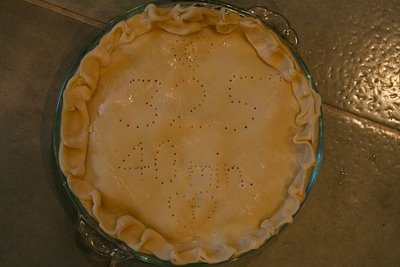
We might as well start with the chicken pot pie. In my packing frenzy as I prepared for ten days in Guyana, South America, I also went into a cooking frenzy. Realizing that baking is not one of Bill of the Birds' myriad fortes, I left instructions on the fully assembled but uncooked pie. Sure enough, he called me at the airport to ask me how long he should bake it. "Just take the pie out of the fridge and look at it!"
There followed a series of long flights, a 10:30 PM arrival at the one-gate Georgetown airport, an 11:30 PM arrival at the Grand Coastal Hotel an hour away, and a comatose night. At 5:30 the next morning, we left for our first outing, a pattern that would continue for the entire ten-day trip: rising in the dark to constant motion until it was time to collapse back into bed. Our destination was a marshy savannah within earshot of Guyana's coast. Here, birds like laughing falcons, named for their ha-ha-hoo-hoo call, stand sentinel on palm trunks.
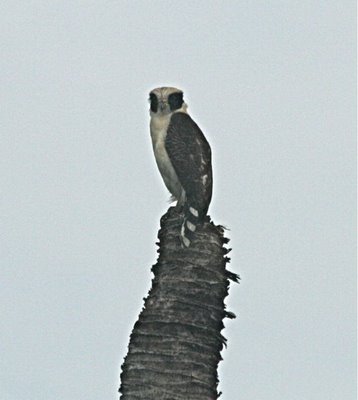
before flying off.
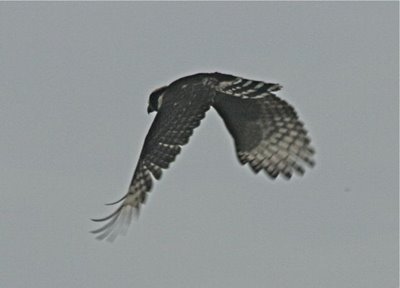
There's nothing like a laughing falcon anywhere in the States, but we do have snail kites--an endangered species, found only in the Florida Everglades. In Guyana, they sit all over the powerlines, diving down occasionally to nab an apple snail from a roadside ditch. It's nice to see them being all abundant. This is an immature snail kite.
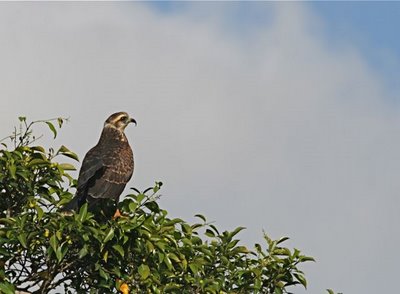
We'll see it use its specialized hooked bill in a future post.
We had a couple of target birds for this outing, found only in Guyana. One was the blood-colored woodpecker, a small bird which cleverly eluded us for the entire trip, showing only bits of itself before winging away, as if headed for Venezuela. I managed to photograph the back and wings of an immature female. I'm told the male is a real stunner. Still, you can see some red on her back.
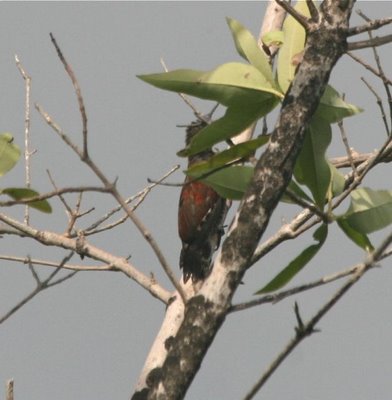
All told, this is typical of my Guyanan bird photos. Now, I got some dandies, but the vast majority of the 2000 exposures I made were garbage. This was without doubt the most challenging environment for photography I've ever encountered: hot and humid as anyplace I've ever been, with a blinding bright sky and deep dark jungles, thick with tangled greenery. Most of the birds were right up against that blinding sky, smack dab in the middle of a vine tangle, or just under the canopy of the deep dark jungle against the bright bright sky. Suffice it to say I learned a lot about the limitations of a camera in these conditions.
Another Georgetown specialty: the white-bellied piculet, sort of like a miniature woodpecker, the size of a small nuthatch. Here's the female, preening. It's OK if you yawn. We were pretty excited, but then we're birders, and the word "endemic" (found nowhere else on the planet) gets our hearts pumping, no matter what the bird looks like.
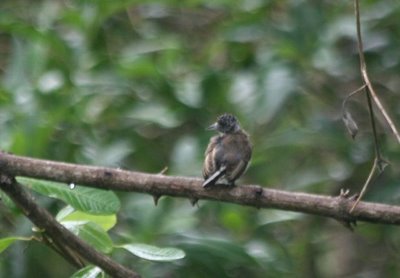
The male dresses it up with a red forecrown, but he is careful to hide behind sticks.
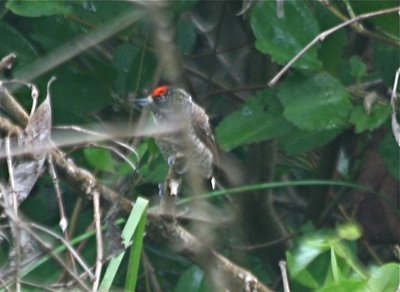
Even those of us with huge lenses succumbed to the conditions, and even got all balled up in our gear from time to time. Here's Michael Weedon, Associate Editor for England's Birdwatching Magazine, trying to figure out which strap goes to which so he can get his camera free. He toted the most gear of any of us, and thanks to that scope and a pocket camera, also got some of the best pictures, I daresay.
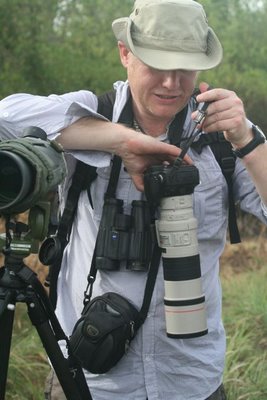
We moved on from the white-bellied piculet to something more powerful: a crimson-crested woodpecker, member of the exalted genus Campephilus, and thus a cousin to our much sought-after ivory-billed woodpecker. Just a peek, but the stance is soooo familiar:
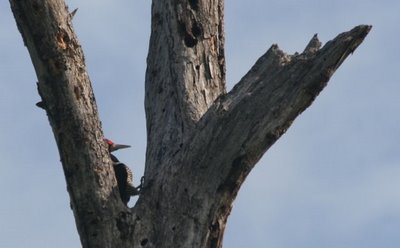
Oh, please come out. I need to see you.
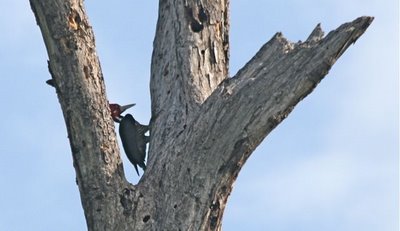
Oooh! Look at your beautiful head!
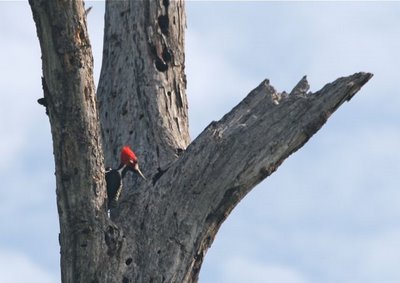
Thank you.
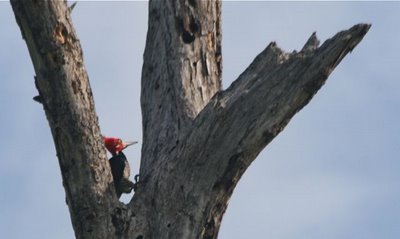 Everything about you, your huge semi-circular claws and your powerful bill, your erect carriage and your proud crest, haunts me, reminds me of what might yet be in our southern swamps.
Everything about you, your huge semi-circular claws and your powerful bill, your erect carriage and your proud crest, haunts me, reminds me of what might yet be in our southern swamps.Because there were lots of things like iguanas
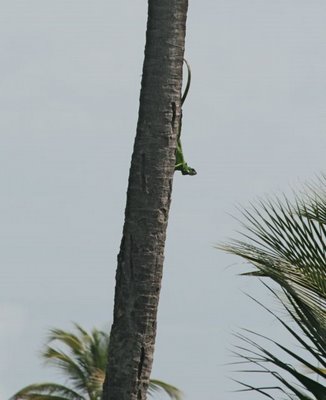
and tegus (a life lizard for me!)
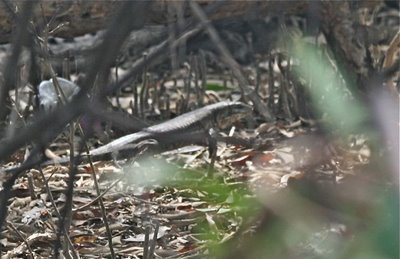
scurrying in the savannah forest, there were lots of things like this rufous crab hawk sitting around scanning for prey. This is a dandy huge gorgeous beast, perfectly lit and situated for his portrait, and, like the piculet, careful to have several branches in front of him for good composition.
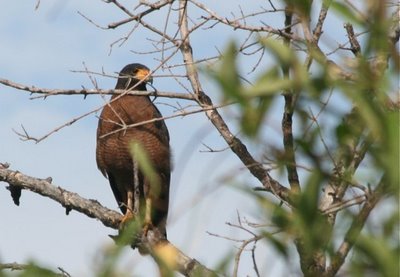
OK, now, try to get me flying through the same branches. Good work.
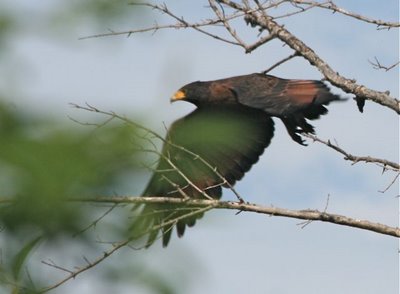
His main dietary item appears as dots in this photo. Like the snail kite, he's surrounded by food all the time. Every dot in this picture is a fiddler crab. Yum!
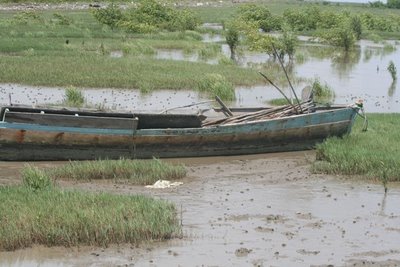
The marshes in Guyana are themselves often dotted with the beautiful little pied water-tyrant, a member of the flycatcher family, which has speciated wildly in South America. There were two full pages of flycatchers in our Guyana checklist, and my eyes glazed over when trying to identify most of them. I prefer tyrants to many other flycatchers, because they are so unequivocally marked.
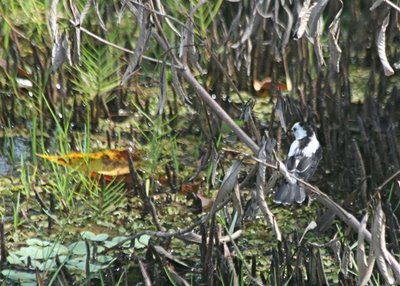
Female and immature pied water tyrants have some black on head, back and wings.
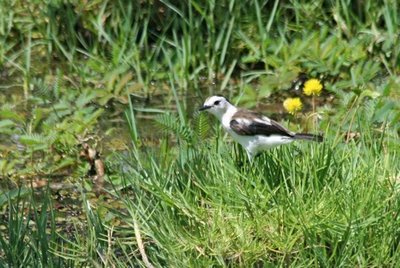
A good male will knock your socks off. I am not sure what the adaptive value of being so obvious might be. It is not obvious to me.
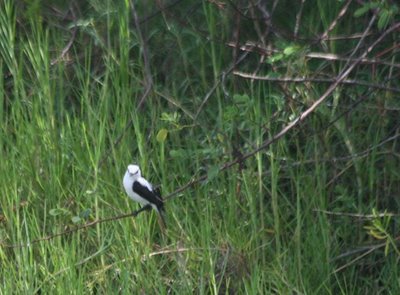
Our guide to all this beauty was Andy Narine, a Rastafarian birder of East Indian (to distinguish from West Indian) extraction.
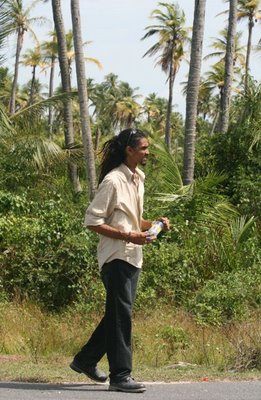 He's one of the leaders in Guyanan birding, keen of eye and ear and encyclopedic of knowledge. His lilting Caribbean accent lapsed freely into musical Creole, gorgeous and sometimes hilarious to hear. We were definitely not in Kansas any more.
He's one of the leaders in Guyanan birding, keen of eye and ear and encyclopedic of knowledge. His lilting Caribbean accent lapsed freely into musical Creole, gorgeous and sometimes hilarious to hear. We were definitely not in Kansas any more. 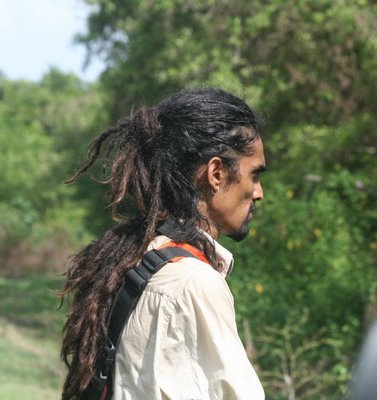
Showing us birds all the way, Andy led us along the coast, where an unexpected dot of scarlet resolved into my life scarlet ibis. I cannot tell you how exciting it was to have a flourescent red bird appear out of nowhere. I was jabbering and hooting and hollering. Pure, vibrant color does that to me, and life birds do that to me, but give me a life bird that is a pure, vibrant color and Sally bar the door.
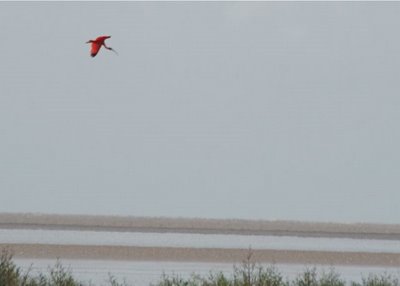
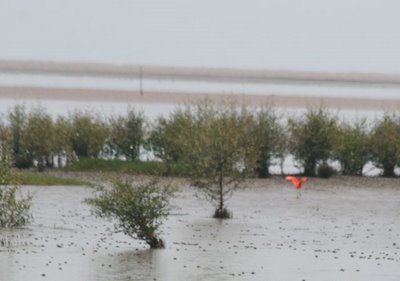
Again, adaptive value of this flaming color: unknown. Just beautiful, that's all.
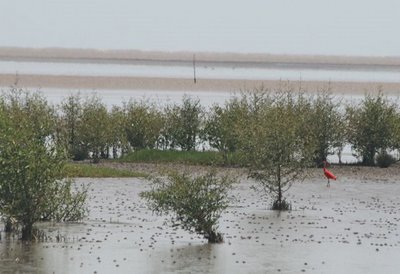
Terry Moore of Leica was kind enough to dial Bill on his cell phone and hand it to me so I could stutter, "Scarlet ibis!!" to my surprised mate. It would be the last time we'd speak for ten days.
Too soon, it was time to drop Andy off at his office, where he heads a natural history society. Thanks so much, Andy Narine. You are awesome and 'ital, mon.
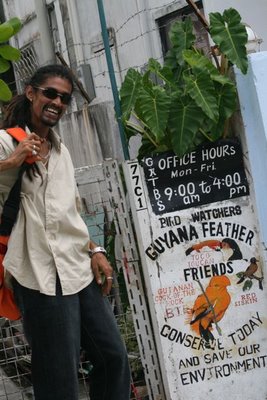






26 comments:
Wow Julie, awesome photos, even if there were branches in the way at times. Durn birds, why don't they cooperate more when getting their pictures taken? Glad to have you back - it looks like you had an amazing trip. And the pot pie complete w/baking instructions right on the crust - that is just the sweetest.
I don't know where to begin because there are so many fabulous photos to take in. That woodpecker photo is awesome. I love how colorful they all are. I am really missing the colorful birds now that it winter here in the U.S.
I love the pie. Very creative and super sweet.
Wonderful post, Julie. The photos and commentary were wonderful, limbs and all. And I loved the ivory-bill cousin...thought I was seeing an ivory bill for a moment.
No yawning here! The Scarlet Ibis, the black & white bird, the woodpecker, and hawk in flight - all mind-boggling to me.
Regarding Michael's gear. How do you think my little bins and Fuji would hold up? LOL!
And, listening to Andy would be music to my ears - perhaps I'd never remember his meaning for my swooning.
Your pot pie baking instructions reminds me of all the post-it notes I tape in the kitchen when I go away. Very loving.
Mary
Only scarlet ibises I've ever seen were in captivity (and thusly very close-up) -- insanely brilliant, breathtaking color -- I always assumed if seen in the wild maybe a reason for such would come to mind, but sounds like you too are baffled by the gaudiness.
I love the pot pie instruction; completely unmissable! And the birds you were able to see are unmatched. Just lovely. Did you have a flash along for your camera? Just a puff of fill flash would be a huge help with the backlit birds high up in the canopy.
Very enjoyable! But "I KNEW" that wasn't an ivorybill! hahaha
Those scarlet ibises...is it something they "et?"
As one who always seems to be strugglng to get the right shot, I understand your disappointment with the camera, but my big question is, "did you sketch?" I would love to eventually see your drawings and paintings from this experience!
This is going to sound like a huge cop-out, but it was so humid that I couldn't make a mark on paper with pencil. As the trip panned out, there was only one morning trip when I could have had a little time to sketch--the rest of the time we were on the move, hiking, unable to linger anywhere. Press trips are grueling to the max--you rarely get to spend two nights in the same place. I do have painting plans, but I'll have to rely on memory, photos and a vivid imagination.
An incredible post about your amazing trip! Wow! Sorry so many of the birds were hard to shoot, but this still had to be an incredible journey! I so much enjoyed reading about it and seeing the photos you were able to get! Oh, and the pot pie pic was so cute! That's definitely what I would have to do for my husband if I were leaving him a pie in the frig! :-)
I agree with you about the beautiful white and black male bird and the scarlet ibis--one wonders how such plumage helps the bird stay safe. I think maybe there's a reason for their coloration...maybe God just said, "Here--enjoy!" And so we do!
Glad y'all are liking it, because you're going to have Guyana birds coming out of your ears for the foreseeable future. I took more than 2,000 photos and winnowed them down to 600 acceptable images. They're all sorted and folded and stacked up in the pantry, and I'm writing the posts while it's all still fresh in my memory. My goal is to shine a light on this little-known and little-traveled country in the hope that you'll consider visiting. Ecotourism will play a huge role in the preservation of Guyana's pristine rainforest.
I love seeing the birds and looking forward to more.
I have to tell you that was brilliant about the pot pie and the baking instructions.
Guyana - bring it on. So far its lip-smacking, wonder inspiring, quivering hand on the frequent flyer phone dialing I WANNA GO. And I want to see all 600 images - don't hold any back.
Yeah, I toted by brand new 400m Canon lens to the Peruvian Amazon all cocky "watch what I can do with this baby - ha" . Brought the lens up to my eye and watched every image disappear under a haze of humidity and condensation. Lenses, sweat, body eat, eye glasses, and myopia do not mix in the jungle! I'll be whimpering out my posts all tail between the legs with my new "i love my macro" attitude now.
Wow, and this was day ONE?? Whew. I hope you were wearing Depends! I would be beside myself seeing so much I'd never seen that I would have forgotten I had a camera around my neck! What a cool place. Can't wait to hear more about the remaining nine days!! Wait, let me go put on my Depends...
Timmo, you always make me feel better. My water bottle came unscrewed in my pack and inundated my 135 mm. lens, as if the fogging from sheer humidity weren't enough. I poured water out of it! Set in the sun, it recovered, amazingly, but now needs to be taken apart and cleaned. We had an early morning full of parrots when nobody could see a thing due to fogging on binocs and cameras. I was tempted to upgrade my equipment before this trip and am so glad I didn't--what a yucky baptism for a new camera! A Leica and a Nikon owned by other participants quit working altogether. Scary humid.
Excellent adventure!
How clever those baking instructions are.
WOW WOW WOW, Zick. What a great post. Thank you for sharing your memorable trip with us!
Regarding the humidity haze issue, I learned on an Artie Morris photo trip to keep the camera (and binocs, I suppose) in a NON-air conditioned area overnight. This way, when you remove them from your hotel room, the glass won't be cold against the hot, humid air and fog up. I don't know if that would have helped in your extreme conditions but it is a helpful trick.
I will have to tell Anne about the pie instructions. That will crack her up.
Only 600 good ones? You're slipping.
Beth--Lucky you, learning from the best. Artie's an old friend of ours. Terry Moore of Leica told us he kept his optics in the bathroom overnight to try to combat fogging. It's a great tip. As it happened that first night was also the last with any air conditioning (or electricity!) We fought fogging the whole trip, and found our removable skylight filters to be particularly susceptible.
Amazing birds Julie!
But I liked your chicken pot pie photo the best--you are one clever woman!
Congrats on getting the scarlet ibis - what an exciting lifer! Can't wait to hear (and see) more...
Beth
This is another amazing post, Julie. The woodpecker is my favorite! My first thoughts were also about what might be found in our Arkansas this winter.
Marvelous photos! I look forward to seeing parrot photos!
How cool, Julie! That scarlet ibis series is sweet. I'm with the rest of the gang in looking forward to more of your Guyana adventures.
I'll take whatever images you can manage--there's something even grander when the habtat is so wild that you can NOT capture it--a magical place cannot be contained.
Post a Comment